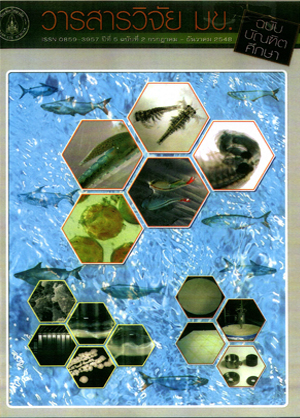Effect of Pseudomonas putida siderophore on plasma iron ผลของไซเดอโรฟอร์ซึ่งผลิตจากแบคทีเรียสายพันธุ์ Pseudomonas putida ที่มีต่อเหล็กในพลาสมา
Keywords:
Siderophore, Lipid peroxidation, MalondialdehydeAbstract
The effect of siderophore produced from Pseudomonas putida on plasma iron was studied by malondialdehyde (MDA) using high performance liquid chromatography with fluorescence detection, X at 532 ททา and X at 552 ท[ท. The separation and detection of MDA were carried out after derivatization
ex cm
by 2-thiobarbituric acid (TBA). optimum chromatographic conditions are a mixture of methanol and 10 mM phosphate buffer (pH 7.4) at a ratio of 40:60 (v/v) as mobile phase with flow rate of 0.8 mL min'1 at 25 °c. A linearity correlation between peak area and MDA at the concentration range of 0.25 - 4.00 X 10“6mol L'1 was 0.9977. The method was proved to be specific detection of MDA with or without the presence of siderophores. This method was used to investigate in 6 plasma samples. The effect of p. putida siderophore was compared with that of desferrioxamine B. MDA concentration concerned with plasma iron content is lowest when treated by p. putida siderophore. It is concluded that the p. putida siderophore can probably reduce the plasma iron at an average of 29.496 (ท=6).
บทคัดย่อ
สืกษาผลของไซเดอโรฟอร์จากแบคทีเรียสายพันธุ Pseudomonas putida ที่มีต่อปริมาณเหล็กในพลาสมา โดยการตรวจวัดปริมาณของมาลอนไดอัลด้ไฮด้ด้วยเทคนิคโครมาโทกราฟ ของเหลวสมรรถนะสูง และตรวจวัดด้วยฟลูออเรสเซนช้ที่ใช้ความยาวคลื่นกระด้นที่ 532 นาโนเมตร และความยาวคลื่นคายแสงท 552 นาโนเมตร การแยกและการตรวจวัด'ปริมาณสารมาลอนไดอัลดิไฮด้เกิดขึ้นภายหลังจากการทำอนุพันธ์ กับสาร 2-thiobarbituric acid (TBA) ได้มีการปรับปรุงสภาวะของการทดลองทางโครมาโทกราฟสำหรับ การวิเคราะห์หามาลอนไดอัลดิใอด้ โดยใช้เฟสเคลื่อนที่เบ็เนสารผสมระหว่างเมทานอลและ 10 มีลลัโมลารั ฟอสเฟตบัฟเฟอร์ (pH 7.4) ด้วยอัตราส่วน 40:60 อัตราการไหล 0.8 มีลลิลิตรต่อนาที ที่อุณหภูมิการวิเคราะห์



